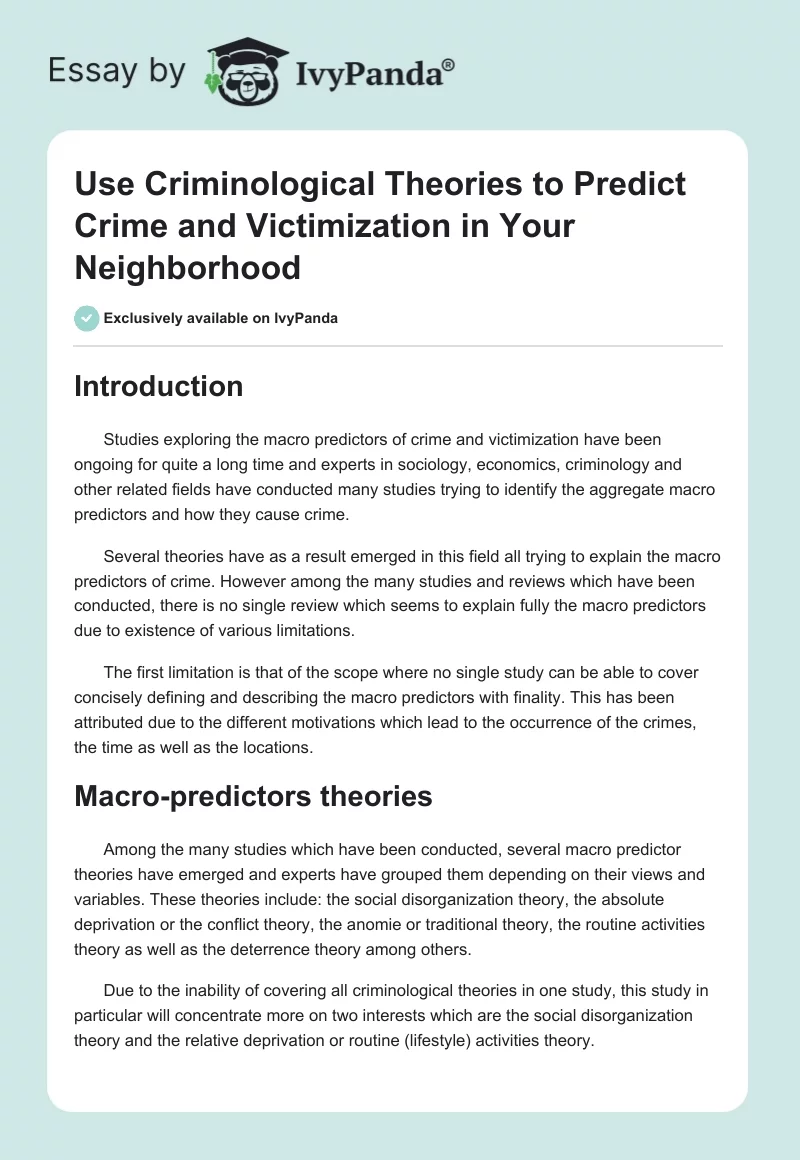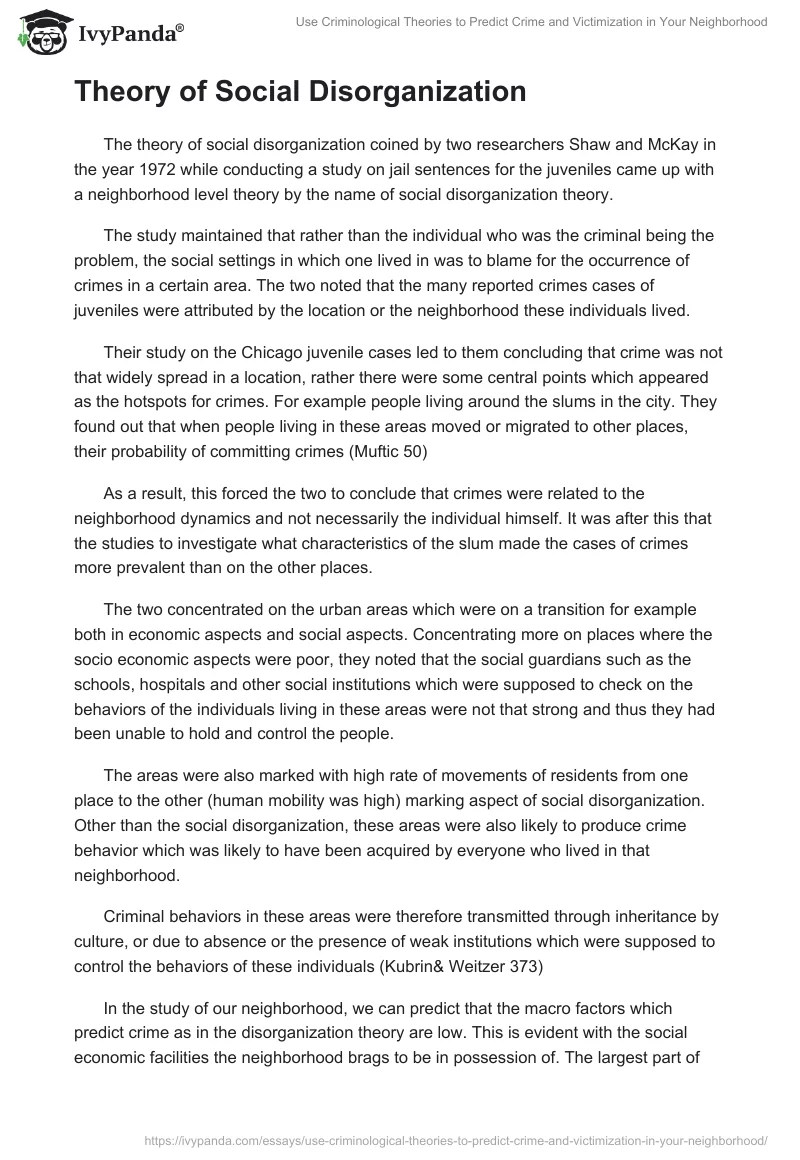Introduction
Studies exploring the macro predictors of crime and victimization have been ongoing for quite a long time and experts in sociology, economics, criminology and other related fields have conducted many studies trying to identify the aggregate macro predictors and how they cause crime.
Several theories have as a result emerged in this field all trying to explain the macro predictors of crime. However among the many studies and reviews which have been conducted, there is no single review which seems to explain fully the macro predictors due to existence of various limitations.
The first limitation is that of the scope where no single study can be able to cover concisely defining and describing the macro predictors with finality. This has been attributed due to the different motivations which lead to the occurrence of the crimes, the time as well as the locations.
Macro-predictors theories
Among the many studies which have been conducted, several macro predictor theories have emerged and experts have grouped them depending on their views and variables. These theories include: the social disorganization theory, the absolute deprivation or the conflict theory, the anomie or traditional theory, the routine activities theory as well as the deterrence theory among others.
Due to the inability of covering all criminological theories in one study, this study in particular will concentrate more on two interests which are the social disorganization theory and the relative deprivation or routine (lifestyle) activities theory.
Theory of Social Disorganization
The theory of social disorganization coined by two researchers Shaw and McKay in the year 1972 while conducting a study on jail sentences for the juveniles came up with a neighborhood level theory by the name of social disorganization theory.
The study maintained that rather than the individual who was the criminal being the problem, the social settings in which one lived in was to blame for the occurrence of crimes in a certain area. The two noted that the many reported crimes cases of juveniles were attributed by the location or the neighborhood these individuals lived.
Their study on the Chicago juvenile cases led to them concluding that crime was not that widely spread in a location, rather there were some central points which appeared as the hotspots for crimes. For example people living around the slums in the city. They found out that when people living in these areas moved or migrated to other places, their probability of committing crimes (Muftic 50)
As a result, this forced the two to conclude that crimes were related to the neighborhood dynamics and not necessarily the individual himself. It was after this that the studies to investigate what characteristics of the slum made the cases of crimes more prevalent than on the other places.
The two concentrated on the urban areas which were on a transition for example both in economic aspects and social aspects. Concentrating more on places where the socio economic aspects were poor, they noted that the social guardians such as the schools, hospitals and other social institutions which were supposed to check on the behaviors of the individuals living in these areas were not that strong and thus they had been unable to hold and control the people.
The areas were also marked with high rate of movements of residents from one place to the other (human mobility was high) marking aspect of social disorganization. Other than the social disorganization, these areas were also likely to produce crime behavior which was likely to have been acquired by everyone who lived in that neighborhood.
Criminal behaviors in these areas were therefore transmitted through inheritance by culture, or due to absence or the presence of weak institutions which were supposed to control the behaviors of these individuals (Kubrin& Weitzer 373)
In the study of our neighborhood, we can predict that the macro factors which predict crime as in the disorganization theory are low. This is evident with the social economic facilities the neighborhood brags to be in possession of. The largest part of the population has bachelor’s degree with both the males and the females being fairly represented while the smallest level of education presented in the School district being level 9.
The females seem to dominate the education levels in the area and thus the high number of schools in the area has helped in guarding the society. Socially, the area is well armed with schools and academic institutions of the highest level (university).
Public and private libraries provide the local individuals with a good environment for those studying and those staying within the study area. Religion is also observed since there are close places of worship. When it comes to health matters, there is a public hospital, dispensaries and private clinics offering medical care and their staffs are highly qualified and skilled. Security is also high with a detailed coverage of a police station and street lightings giving everyone the freedom to walk safely to their homesteads without being questioned by any one.
In such an area as the school district, the social disorganization is very low and thus using the crime predictors as used under the disorganization theory, we can predict that the rate of crimes and also the victimization levels are likely to be low due to the existence of strong social economic guardians.
Routine Activities Theory
With each of the criminological theory giving different macro predictors, one thing which is common among them is the fact that they each try and give examples of what motivates individuals to commit crime. The theory of routine activities explains that occurrence of criminal activities bears its relationship with the common fundamental elements such as time and location where these elements either increase or decrease the likelihood of an individual engaging in crime.
From Cohen and Felson (589) the two researchers who came up with this theory, there are three variables which motivate individuals into committing crimes. The three variables are: the presence of motivated offenders, existence of suitable targets and finally the absence of a capable guardianship of either property or persons.
According to the two, if there “was convergence in space and time of the three minimal elements of direct-contact predatory violations then crime is likely to occur” (Cohen and Felson 589). The theory explains that it is the routine activities or what people are used to follow (schedules) that sometimes enter them into social arenas where they become crime targets. Crime is therefore in this theory connected to the dispersion activities such as employment and leisure activities which help in prediction of criminal victimization.
They assume that in the absence of something which can deter the individual from committing the crime, it will just be committed. The theory therefore concludes that given the chance or the opportunity, offenders are likely to commit the crime if the possible social guardians are absent or weak to prevent them from committing the crimes.
To measure criminal activity, this theory used the house hold activity ratio which is got by adding the number of married wives to the number of non husband and wives headed households, the total is then divided to the total number of households.
If the variable obtained is high, this is a clear indication that the numbers of activities outside the household are high in this instance, one would expect less guardianship in the household translating to high chances of property victimization.
A high figure of house hold activity can also indicate high levels of interpersonal relationship thereby heightening chances of predatory victimization. Finally, the high number of females employed can also indicate less supervised children bringing about social problems. Other possible causes of crime are due to labor segmentation as well as huge disparities on income (Entorf & Spengler 40)
From the statistics of the School district, we observed that about 52 percent of the population is employed with about 14% being non-employed. According to the routine theory, this could lead to occurrence of crimes in the area due to the high number of unemployed individuals.
However, contrary to that assumption, we are informed that the neighborhood is safe for everyone and one can walk freely at any hour of the day or the night without being questioned by any one. The percentage of women working for long hours is high at a percentage of 52%.
According to the household activity, such high levels could present a social problem if these women are guardians of their families as that would mean their children stay at home with little or no guidance and as a result this may translate to crime activities as the children grow the disparity in the income earned is not that big and thus we do not expect high prevalence of crimes as it is the case.
From the interview of the neighbor, there is the presence of a police station and everybody can get out of his house safely any times even in the middle of the night without fear of being asked. The police station acts as deterrence since it prevents usual offenders from committing crimes as claimed by the routine theory.
Type of policies (driven by the theories you have chosen) would be helpful in the neighborhood’s predicted crime/victimization levels
With both the crime and the victimization of both persons and property being low in the School District neighborhood, the guardian institutions such as the street lighting which provide light through out the night and the police station which prevents individuals from committing crimes should continue being in place as they play a role in preventing occurrence of crimes.
The presence of strong socioeconomic structures such as the hospitals, schools, colleges and universities has contributed to the low crime rates. People from this area have got some place to engage in during their free time and with the highest percentage of the population being highly educated and employed (self by government or company) this has contributed to the low reported numbers of crimes rates in the area.
As a result, I would encourage other places where crime rates are usually high to embrace the same initiatives as in the school district and the rates of crime and victimization of persons and property would decline. Laws and policies should be put in place which ensures that every place is well equipped with the social economic structures.
Works Cited
Cohen, Lawrence and Felson Marcus. Social Change and Crime Rate Trends: A Routine activities Approach. American Sociological Review, 44(1979): 588-608.
Entorf, Horst and Spengler Hannes. Crime in Europe: Causes and Consequences. New York: Springer Publishers, 2002. Print.
Kubrin, Charis and Weitzer Ronald. New Directions in Social Disorganization Theory. Journal of Research in Crime and Delinquency, 40. 4(2003): 374-402
Muftic, Lisa. Macro-micro theoretical integration: an unexplored theoretical frontier. Journal of Theoretical and Philosophical Criminology, 1. 2(2009): 33-71
Pratt, Travis. Assessing the relative effects of macro-level predictors of crime: a meta- analysis. University of Cincinnati. 2008. Web.
Shaw, Clifford and McKay Henry. Juvenile Delinquency and Urban Areas. Chicago: University of Chicago Press, 1972. Print.


